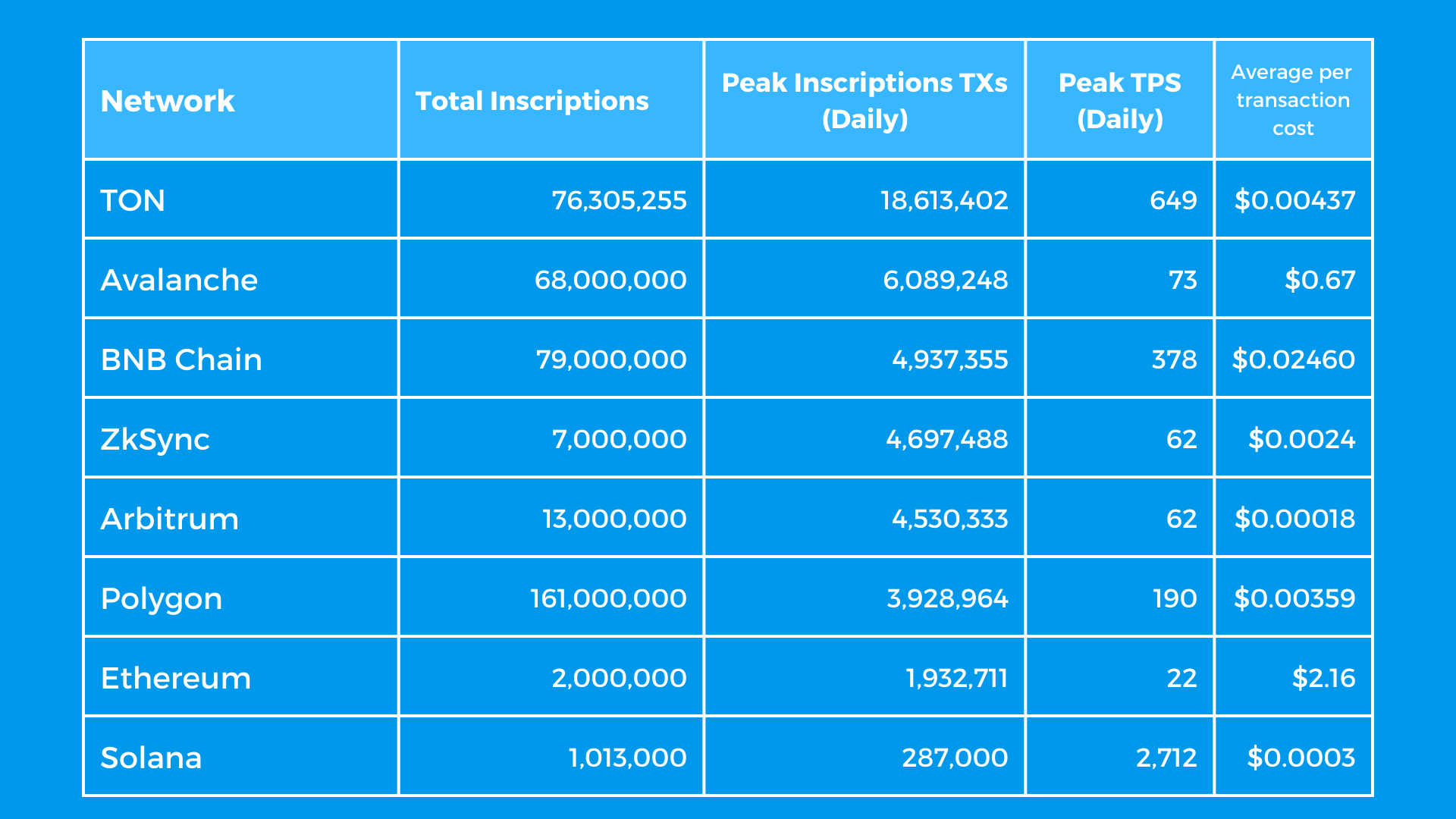
Inscriptions on TON
Prior to the launch of inscriptions, TON averaged around 50,000 daily transactions, with a total transaction count of 198 million. Since December 5, activity has surged to an average of 1.5 million daily transactions, pushing the total to 274 million—an almost 40% increase in just 15 days.
This surge appears to be just the start, as more inscription protocols are expected to launch on TON soon. With Tonano and ShardZone already in place, and Gram20 currently launching, the momentum continues to build.
What Are Inscriptions?
Inscriptions began on the Bitcoin blockchain with the Ordinals protocol, created by software engineer Casey Rodarmor. This protocol was designed to embed data directly onto individual satoshis—the smallest unit of Bitcoin—allowing for the creation of unique digital assets within the Bitcoin blockchain, which was not originally intended for such functionality.
In recent months, the concept of BRC-20 tokens, initially a workaround for Bitcoin’s lack of native token support, has expanded to other blockchains. These tokens, adapted to fit various blockchain platforms, now appear under different names such as PRC-20 on Polygon PoS, Ethscriptions on Ethereum, Doginals on Dogecoin, and Solana Inscriptions on Solana. This expansion has significantly increased network activity across all participating blockchains, and now, they have arrived on TON, where no official standard has yet been established.
Challenges with Inscriptions
The rise in blockchain activity due to inscriptions has posed challenges for many networks, especially Bitcoin, where there is debate among core developers about whether this development should be considered spam or an innovative advancement.
For blockchains like Bitcoin, Ethereum, and Avalanche, increased demand from inscriptions has led to higher transaction fees and, at times, has made the networks nearly unusable. Other chains, such as TON, Arbitrum, and ZkSync, initially struggled with the increased transaction load, resulting in issues like network congestion and temporary halts.
TON also faced growing pains, with validators needing to manage the sudden surge in transaction volumes. However, the TON Core Development Team acted promptly, collaborating with validators worldwide to address the congestion and keep the network running smoothly.
Why Are Inscriptions Gaining Popularity?
Despite these challenges, inscriptions are gaining traction for several reasons:
- Innovation: Inscriptions introduce a novel approach to blockchain technology, offering a unique method for creating and managing tokens.
- Cost Efficiency: Tokens created through inscriptions generally incur lower transaction costs compared to those built on smart contracts on other blockchains.
- Accessibility: The process of creating inscriptions is more accessible, resembling the simplicity of proof-of-work mining.
- Speculation: As with many cryptocurrency trends, inscriptions attract investors due to the potential for rapid value appreciation.

Why Are Inscriptions Coming to TON?
Inscriptions have demonstrated their potential across various major blockchains, but their success depends on finding a high-performance blockchain to handle the associated issues of transaction fees and network congestion.
TON is well-suited to this role for several reasons:
- High Performance: TON can achieve speeds of up to 104,715 transactions per second, as demonstrated in a recent record attempt. Although this test was conducted on a testnet to prevent disruptions, it showcased TON’s scalability. The network recently reached its 200 millionth transaction and is projected to hit 300 million within 30 days.
- Stable Fees: TON maintains a fixed fee structure, keeping transaction costs low even during peak loads. Since the launch of inscriptions, the average fee has been just $0.004 per transaction.
- Telegram Integration: TON’s integration with Telegram offers a unique distribution channel, enabling the 800 million Telegram users to easily access a TON wallet and perform transactions directly within the app. This feature enhances user experience and project reach.
Use Cases for Inscriptions
Inscriptions, being unique tokens, share similar use cases with traditional tokens based on smart contracts. Major use cases include:
- Fair Token Launch: Unlike regular smart contract tokens, inscriptions are minted by users, who only pay for transaction fees. This method ensures fair distribution as no user has an advantage, potentially setting a new standard for initial token launches.
- Collectibles and NFTs: Inscriptions can function as NFTs, allowing unique data such as images or text to be attached to individual cryptocurrency units. This capability offers a new avenue for digital art and media to be stored, authenticated, and traded.
In summary, inscriptions on TON represent a significant evolution in digital tokens. While they present some challenges, their potential for innovation, cost efficiency, and unique use cases make them a noteworthy development in the blockchain space. As the TON Ecosystem continues to grow, the impact of inscriptions will likely become even more pronounced.